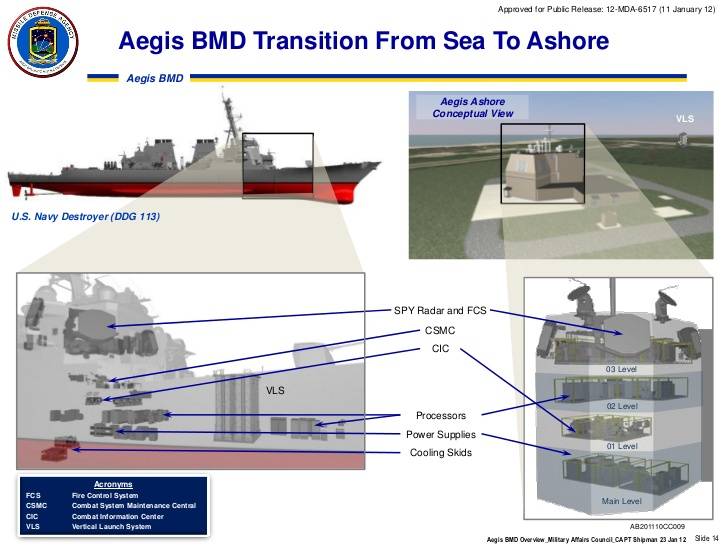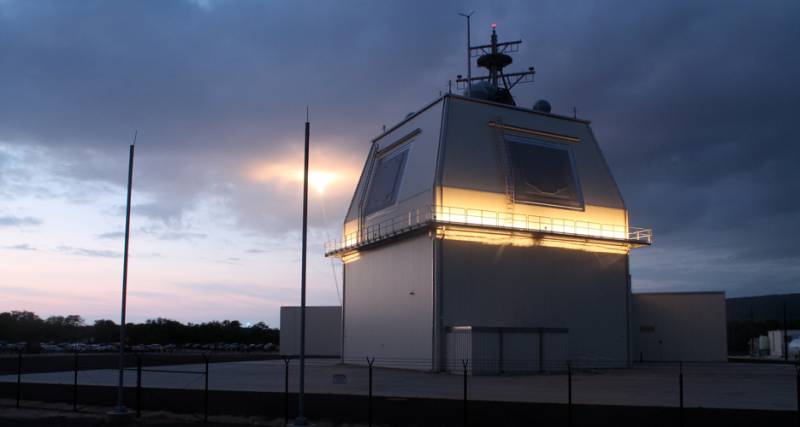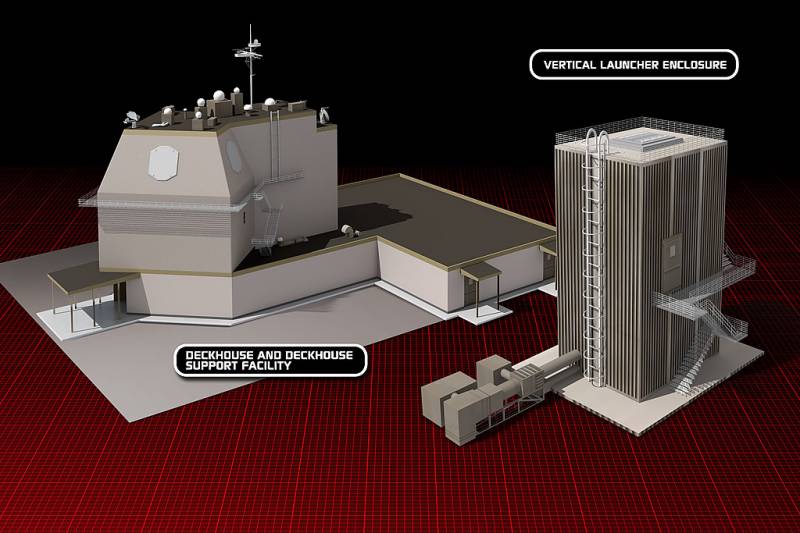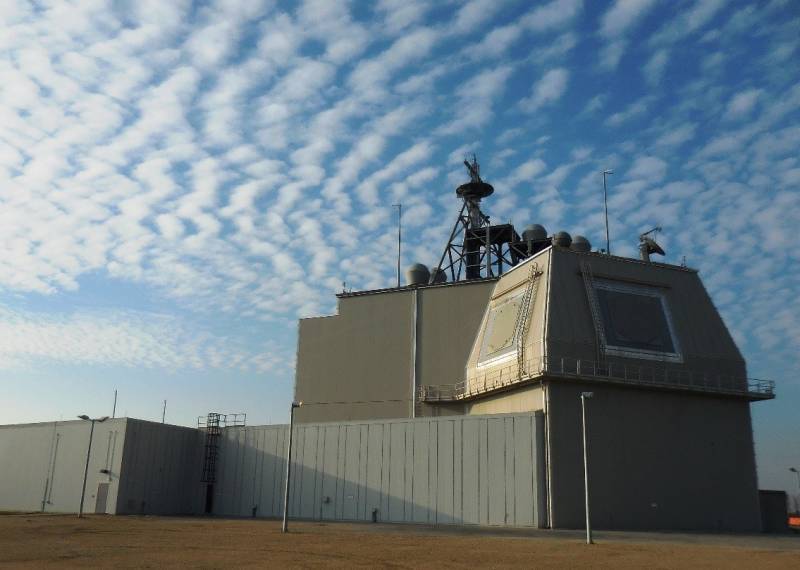Aegis Ashore anti-missile complex: a land ship and a security threat
Currently, the arsenal of the United States and a number of friendly states consists of a number of missile defense complexes, differing in their characteristics and capabilities, deployment method, etc. One of the foundations of the most complex and largest missile defense system are ships with combat information and control system Aegis BMD, created to intercept ballistic missiles. A few years ago, a unified ground-based system was created on the basis of the shipboard missile defense complex.
Material part
The new project of the land system received the designation Aegis Ashore, indicating the method of placement of its components. The main contractor in the development of this project was the company Lockheed Martin. In addition, a number of other organizations that had previously participated in the creation of the Ajis basic marine system were attracted to the work. The design work was completed in the first half of the current decade, and then the new missile defense system was put to the test.
At the heart of the Aegis Ashore project is the simplest idea that allows you to organize the missile defense of a given area without the need to develop completely new systems. It consists in placing the equipment, originally developed for ships, on appropriate land facilities. Despite a different placement option, such a complex retains all the capabilities of the basic ship sample. It should be noted that it was precisely these features of the Aegis Ashhor project that led to disagreements in the international arena.
The Aegis Ashore project provides a curious way to deploy the necessary equipment. It is proposed to build several structures of different configurations on the antimissile base. For example, a multi-storey building should be built to house the radar, which looks like a superstructure of the ships of the Ticonderoga and Arleigh Burke projects. At a certain distance from the radar station and the command post, a “box” should be built to accommodate the vertical anti-missile launcher.
The composition of the main components of the land-based system is almost not different from the ship. The AN / SPY-1 radar with a passive phased antenna array is still used to monitor the situation in air and space, search for targets and target designation. On one structure, several antenna arrays are mounted, which allows you to monitor a large sector and to receive data on dangerous objects in a timely manner.
The equipment for data processing, target designation and fire control, as far as is known, was also borrowed from the Aegis BMD ship complex. At the same time, as claimed by officials, the ground-based complex lost some of the devices and software. This was done to avoid violations of international treaties. However, this question still remains a reason for disputes at different levels.
For firing antimissiles, the universal vertical missile launcher Mk 41 was included in the missile defense system. In the basic version, this product is placed in the hulls of existing and under construction ships. To use such a launcher on land provides for the construction of a special structure, inside which are placed all the necessary units. In addition, such a structure is equipped with means of loading rockets into vertical cells.
The main means of destroying enemy ballistic missiles in the Aegis Ashor complex are SM-3 interceptor missiles. it weapon, originally created for ships with missile defense functions, together with other equipment was adapted for use on land. Like the original ship complex, the land system is able to use all existing SM-3 missiles, regardless of their modification.
At present, the main ammunition of the Aegis BMD complexes in two versions of the base is the anti-rocket RIM-161C SM-3 Block IB. This product is equipped with a dual-band infrared homing head and carries out target interception using a special kinetic combat stage. Developing a flight speed of up to 3 km / s, such a rocket is capable of hitting a target at a distance of up to 700 km.
In the foreseeable future, the SM-3 Block IIA rocket, which is distinguished by higher performance, will have to enter service. Due to the use of the new power plant, such ammunition will have to reach speeds of up to 4-4,5 km / s. The firing range will be increased to 2500 km. The project also provides for the use of new guidance systems, which, as expected, will also markedly increase the fighting qualities of the rocket.
It should be recalled that in addition to the SM-3 interceptor missiles, other types of weapons are included in the ammunition assembly of the Ticonderoga and Arly Berk ships. Cruisers and destroyers are capable of carrying SM-2 anti-aircraft missiles and other anti-submarine weapons, as well as surface-to-surface missiles of the Tomahawk family. According to official sources, during the adaptation of the Aegis complex to use on land, it was decided to abandon part of its equipment. Thus, in the composition of the Aegis Ashore there are no systems used for firing with “traditional” anti-aircraft, anti-submarine or attack missiles. However, such statements are criticized.
Polygons and combat positions
21 May 2014 The Pentagon officially announced the launch of the first test launch of the SM-3 rocket with the Aegis Ashor test complex. The complex, built in Hawaii, launched the Block IB anti-rocket anti-rocket. Reportedly, the launch was normal. At the same time, during the first test, no training targets were used. However, the need for such a check could be absent: the anti-missile version of the Aegis system passed all tests for a long time and showed its capabilities. Thus, checks of its coastal version could be limited only to the confirmation of the operability of the equipment placed in the new structures.
Shortly after testing, construction of new missile defense facilities began. The first complex Aegis Ashore was laid in Romania, at Deveselu air base. By the end of spring 2015, construction work at the site was completed, and at the end of the year, operational readiness was announced. In May, the 2016-th new complex was officially put into operation. From this point on, the land-based radar began monitoring the situation, and the interceptor missiles took over for duty, waiting for the command to start.
Currently, construction and installation work is underway in Poland, near the village of Redzikovo. The second object Aegis Ashore should be completed, checked and put into operation next year. As far as is known, in terms of its equipment, this anti-ballistic missile defense base will be similar to the one already put into operation in Romania. Two new facilities in Eastern Europe will have to tackle similar tasks in different regions. Thus, the missile defense system on Polish territory will cover the northern regions of Europe, while the “Romanian” will have to defend the southern borders.

Transfer of ship equipment to the ground structure. Slide from the presentation of the Agency for ABM / slideshare.net
Not so long ago it became known about the future construction of two more missile defense facilities, this time in Japan. In connection with the deteriorating situation on the Korean Peninsula and the growing threat from the DPRK, the official Tokyo expressed a desire to build on its territory two Aegis Ashore complexes. As reported at the beginning of the year, it will take several years to build these facilities, and by 2023, Japan will receive protection from a hypothetical nuclear missile strike. One complex will be deployed in Akita Prefecture, the second - in Yamaguchi. Each of them will cost the treasury 80 billion yen (about 730 million US dollars).
A few days ago, the Japanese press reported that the country's military department was not happy with the schedule of work on the deployment of anti-missile systems. It intends to request additional funding, with which it will be able to speed up construction in the 2018 fiscal year. This requires 730 million yen (6,4 million dollars). The increase in financing in the near future will make it possible to speed up the construction to a certain extent and thereby bring the start of operation of the finished complexes closer.
According to various sources, other countries also showed their interest in the Aegis Ashore missile defense system, but in their case the matter has not yet advanced further conversations and discussions. According to current plans, such systems will be deployed in only three countries. Two antimissile bases will operate in Eastern Europe, two more in the Far East. A possible increase of such a group has not yet been reported.
Motives for criticism
Quickly enough, the Aegis Ashore project was severely criticized by Moscow and Beijing. Foreign experts noted that a promising anti-missile system, characterized by an interesting "origin", may have characteristic capabilities. Moreover, some opportunities that go beyond the stated limits directly contradict existing international treaties.
First of all, the Aegis Ashore complex, like the other anti-missile systems of the United States, was called a means of changing the strategic balance. By deploying missile defense systems in close proximity to the Russian or Chinese borders, Washington shows its desire to gain advantages in a hypothetical conflict with the exchange of nuclear missile strikes. The theoretical possibility of intercepting some of the potential enemy’s missiles shortly after their launch gives the United States certain advantages. At the same time, the balance of power in different regions is disturbed, which definitely will not lead to positive consequences.
Politicians also noted the specific technical and combat capabilities of new facilities. The fact is that the basic ship variant of the Aegis BMD complex can use not only interceptor missiles, but also other guided missiles. And if the use of anti-submarine missiles on land looks meaningless, then compatibility with Tomahawk products is the most serious cause for concern. From a technical point of view, Aegis Ash can maintain compatibility with cruise missiles and be used to launch them.
Placing Tomahawk missiles on land bases in Eastern Europe or Japan represents a great threat to Russian and Chinese objects. In addition, the use of such weapons with the Aegis Ashore complex directly contradicts the terms of the treaty on the elimination of medium and short-range missiles. Among other things, this agreement provided for the rejection of ground-based cruise missiles.
For obvious reasons, official Washington does not recognize the possibility of using missile defense systems as a means of delivering a missile strike. According to official American information, the Aegis Ashore complex does not have the ability to fire cruise missiles, since it lacks certain devices and does not use certain software. However, and this is the reason for new issues. First of all, politicians, specialists and the public want to know how difficult it is to supplement Aegis Ash with the necessary devices and programs.
Thus, in the existing configuration, US missile defense facilities may threaten the interests of Russia and some other countries, and for two reasons at once. The use of SM-3 family antimissiles can change the strategic balance in a region with negative consequences for the international situation. Officially rejected, but maintained at a theoretical level, the possibility of firing land-to-ground cruise missiles, in turn, turns out to be a direct threat to the security of neighboring countries.
For years now, Russia and China have been talking about the dangers associated with the deployment of US missile defense systems, including the land version of Aegis BMD. The military and political leadership of the United States, however, does not pay special attention to such criticism and continues to build new facilities. In addition, the SM-3 missile development program continues, the new results of which will be implemented not only on ships, but also on land complexes.
The near future and missile defense systems
As follows from recent events, the American side does not intend to curtail its program to build new anti-missile defense facilities, including the Aegis Ashore complexes. In the early twenties, two similar facilities will be put into operation on Japanese territory, with the result that the United States and its allies will have a sufficiently developed network of missile defense systems. With their help, it will be possible to control and cover Eastern Europe, as well as the northern part of the Asia-Pacific region.
The statements and actions of Washington, observed in recent years, directly indicate that he does not intend to stop the development of his global missile defense system. As a result, countries whose interests affect the emergence of such a system need to take certain measures. Available information about the architecture, capabilities, and combat qualities of missile defense systems, including Aegis Eshor, makes it possible to draw up an approximate circle of solutions.
To deliver a full-scale strike when the enemy uses anti-missile systems, missiles with missile defense weapons and, possibly, electronic warfare systems are needed. The latter will have to interfere with the work of missile defense detection devices, and missiles equipped with their own means of penetration will be able to pass through the remaining protection. In this case, at least, a certain part of the missiles will be able to hit these targets.
Actively denied the possibility of firing cruise missiles also requires appropriate measures. They can be a developed airborne defense on the proposed routes of missiles. This will make it possible to timely knock out a significant part of the missiles. Other missiles must be intercepted by air defense, which is responsible for covering their targets.
It is obvious that the existing problem with the US missile defense systems has, at a minimum, a theoretical solution. In one way or another, you can reduce the negative impact of new complexes and partially maintain the desired balance of power. However, in all this there is one negative point. The deployment of missiles with means of overcoming and advanced air defense transfers the solution of topical issues to the military plane. The accumulated problems should be solved by the authorities and diplomats, but one of the parties to the tacit conflict does not want to abandon its plans. What this will lead to will be known in the future.
On the materials of the sites:
http://mda.mil/
http://navy.mil/
http://defensenews.com/
http://globalsecurity.org/
https://defenseindustrydaily.com/
http://ria.ru/
http://tass.ru/
http://news.usni.org/
https://lockheedmartin.com/



Information